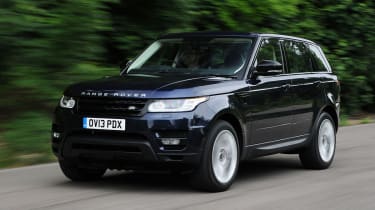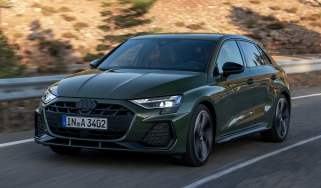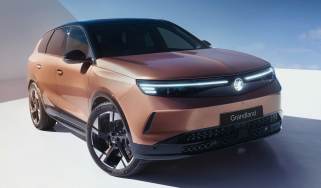Range Rover Sport SDV6 HSE Dynamic
Luxury, power and off-road ability make a formidable package
Building the Range Rover Sport on the Range Rover platform was a smart move. The new car is as comfortable as its bigger brother, but has the performance and handling to do justice to its name. Add superb off-road ability, and it could be the best all-rounder on sale today.
From the moment you set eyes on the Range Rover Sport, you’ll be in no doubt about which company makes it. If you fed the designs of the full-size Range Rover and compact Evoque into a computer and asked it to come up with an average of the two, the result would look a lot like the Sport.
The new car is bigger than its predecessor, thanks to a move from Discovery running gear to the Range Rover platform. It looks a lot sleeker than its big brother, however, with a rounded nose that combines the two-bar Evoque grille with Range Rover lights.
Raised bonnet corners are a very familiar design touch, and they’re complemented by fake vents in the front wings. Further back, the windscreen is raked at a steeper angle than the Range Rover’s and the side windows narrow to an angled rear screen, just like the Evoque. Finally, black window frames create the familiar ‘floating roof’ effect. Overall, the Sport looks smart, and unless it was parked next to a full-size Range Rover, you could easily mistake it for the brand’s larger car.
Climb inside, and you’re greeted by a cabin with all the high-quality touches you expect from a Range Rover. There’s plush leather and a wide centre console with a Jaguar F-Type-style trigger gearlever. The dash design is a variation on the Range Rover’s and includes a TFT display for the dials, plus a large centre console screen and touch-sensitive buttons.
As the Sport is larger than its predecessor, there’s now even more room inside. The two individual back seats are similar in design to the front pair, and there’s enough room between them for a third passenger. A flat floor means there’s plenty of rear legroom for everyone, and if you need to carry seven, you can add a pair of small seats in the boot for £1,500. The electric tailgate opens wide and high, and the Sport has the biggest boot here with the rear seats in place. It loses out to the Mercedes with the seats folded down, however.
At launch, the Sport is available with a 5.0-litre supercharged petrol V8 or the 3.0-litre diesel V6 we tested. Our car has 288bhp and 600Nm of torque, so is more powerful than both its rivals, but while the Sport is 420kg lighter than before, it weighs 2.1 tonnes, so the Cayenne was still faster.
The Range Rover finished a close second, with its performance aided by a smooth eight-speed auto. You can change gear yourself with the lever or steering wheel paddles, but the latter feel cheap compared to the Porsche’s metal items. No matter how you drive, the box does a good job of finding the right gear.
The Sport lives up to its name in a straight line, and it’s hugely capable through corners, too. In Dynamic mode, the dials switch from white to red, the standard air-suspension is stiffened and the dynamic chassis control system works its magic, delivering extremely flat cornering. Where the ML – and, to a lesser extent, the Cayenne – lean on their suspension when cornering hard, the Sport stays upright. It’s a strange sensation when you’re sitting so high, but there’s immense grip on offer, and a standard torque vectoring system ensures the Sport doesn’t stray from its line, either.
Of course, that’s not the only string to the newcomer’s bow. It’s just as comfortable as the Range Rover and boasts greater off-road ability than almost any owner is likely to use.The updated Terrain Response 2 system can switch the transmission between modes to suit conditions, while extras like a surround-view camera and a wading depth sensor help the driver make the most of the car’s ability.
When it comes to the numbers, the Range Rover Sport HSE Dynamic we tested costs over £15,000 more than its rivals, at £64,995. However, it makes up for this with a long list of standard equipment. Heated leather seats, metallic paint, a reversing camera, an eight-speaker DAB stereo with touchscreen sat-nav and the uprated suspension are all included. There’s also a raft of paint and wheel options to choose from, plus extras such as surround-sound speakers and a pair of rear seat screens.
In terms of running costs, the Sport emits the most CO2 here, at 199g/km, so company car and road tax bills are steep. It returned the poorest fuel economy on test, too, at 25.7mpg – although that’s a big improvement over its predecessor.
The newcomer is expensive, but its depth of talent may be enough to justify the price.



